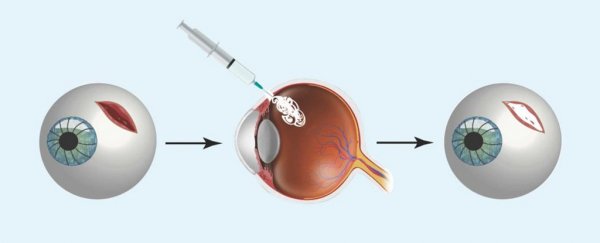A new type of temperature-sensitive gel, which can protect a wounded eyeball and then later be removed with cold water, could be vital in saving the vision of people who get injured a long way from the nearest medical facilities.
The liquid has been developed with soldiers in mind – if they get hit on the battlefield, it's a race against time to get them treated before eye damage becomes permanent.
According to the team from the University of Southern California, the new substance is easy to apply, and will reduce overall treatment times as well as keeping the eye preserved while patients are in transit, whether from the front line or rural areas.
"First responders at a mass casualty incident could deploy the hydrogel while patients wait for their injuries to be completely repaired by an ocular surgeon in appropriate microsurgical facilities," says lead researcher Mark Humayun.
"It could also be useful in ERs in rural areas where there isn't an eye centre with such capabilities nearby. It may even have potential for temporarily treating gunshot wounds."
When asked for help by the US Department of Defense (DoD), the USC researchers adapted a hydrogel called PNIPAM, or poly(N-isopropylacrylamide), which they had already been working on.
Crucially, it takes a liquid form when cooled but becomes a viscous semi-solid with strong adhesive properties when warmed up – perfect for sealing up a wound while also being easy to remove at a later stage.
"Since the initial hydrogel's transition temperature was very close to the temperature of the human eye, we had to modify its properties to ensure that it would form a solid seal as soon as the gel was applied to the eye by a soldier or medic," says one of the team, Niki Bayat.
"Providing a perfect, yet reversible seal, the smart hydrogel shows promise for the next generation of tissue adhesives."
As well as the gel, the team has also developed a syringe for delivery. Simple to use, it cools the substance before it's applied using calcium ammonium nitrate crystals, as used in instant ice cold packs. Add water, and the hydrogel is ready to go in 30 seconds.
Whereas existing patch up jobs would take 30 minutes or longer, this hydrogel can be applied in five minutes before the patient is on his way, and that could free up valuable time in an emergency. The researchers say it's as easy as caulking a bathroom seal.
So far though, the gel has only been tested on rabbits, with clinical trials slated for 2019, so it'll be a while before the treatment can be sent to the front lines or anywhere else.
However, in the animal trials run so far, the material was shown to ease pressure on the eye, which can be crucial in avoiding permanent damage. What's more, the researchers saw no inflammation or infection up to four weeks after use.
With more than 2.5 million eye injuries a year in the US alone, a treatment like this could make a difference to a significant number of people who need help fast.
And it's no wonder the US DoD has requested help from scientists in developing a fix like this, as injuries relating to this most delicate of human organs have risen sharply on the battlefield, partly due to the changing nature of combat.
"If you look at historical data over the last several decades, the rate of war-related ocular injuries has steadily increased from a fraction of a percent to as high as 10 to 15 percent," says one of the researchers, ophthalmologist John Whalen.
"Some of that can be attributed to changes in warfare, especially with the use of improvised explosive devices."
The research has been published in Science Translational Medicine.
